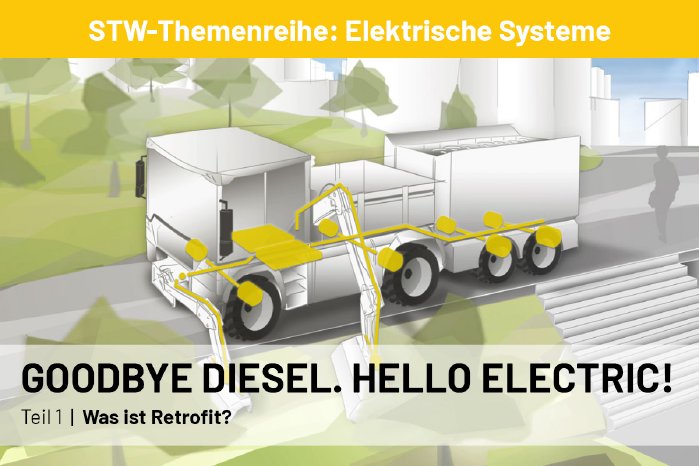www.stw-mm.com/news
With 35 years of experience in the digitalization, automation and electrification of mobile machines, we support our customers with customized workshops, the right concepts and suitable system architectures. But what exactly is this electrification? And how can I integrate it into my business model?
Electrification is becoming part of our everyday lives: Charging parks are being created, battery cell research is being carried out and more and more often we see (but do not hear) an Audi e-tron or a Tesla Model 3 driving by. According to the German Federal Motor Transport Authority (KBA), 17.4% of the new registrations in June 2020 were vehicles with hybrid or electric drives.
However, a completely new development for electrification such as in the automotive sector is not always profitable. For vehicles with special superstructures, models with very small production quantities or projects with only one prototype as a demonstrator, there is also a different solution: Breathing new life into the existing diesel vehicle by removing the old combustion engine and installing a new, electric drive line.
This method – known as ‘retrofit’ – enables both an extended service lifetime and a more environmentally friendly operation of the vehicle in the future. In comparison to a new development, the retrofit is the significantly more cost-effective option.
But the retrofit does not only score points in terms of purchasing costs. The entire J1939 environment remains unchanged, so that the typical drive line components such as brake management systems or chassis controllers can be retained and ensure functionally safe operation of the vehicle in accordance with the applicable standards (e.g. ISO 26262). This not only reduces the effort required for homologation of the new overall system, but also eliminates the need to integrate new components to fulfill these functions.
If the aim is to sell both an electric and a conventional version of the vehicle, the retrofit considerably simplifies the product maintenance effort, as many (sub) systems remain identical.
With the ELIAS project, which was sponsored by Bayern Innovativ, a 44-ton MAN series tractor truck was converted into a battery electric vehicle through retrofitting. The companies involved in the project are Ansorge Logistik as user, Toni Maurer as vehicle manufacturer and STW as electronics specialist for drives, energy management and safety. However, the aim was not just to convert the vehicle to an electric drive, but to preserve all driving and comfort functions. ELIAS more than fulfilled all these requirements.
The electric truck features higher driving dynamics and lower noise emissions. And there is no need to worry about range, because ELIAS can cover an impressive 200 km when all four battery packs are integrated. If that is not enough, the vehicle can be charged with 150 kW at all public DC charging stations.
Within the scope of this project, STW developed special components for the retrofit, i.e. with standard interfaces for connecting to the conventional part of the vehicle. The controller, which behaves like a diesel engine via J1939, can be connected to the existing CAN structure. The electric motors, which are combined via summary gear, can be coupled directly to the manual transmission via an SAE 1 flange. All these features are combined in the STW powerMELA.duo280 drive kit.
powerMELA.duo280




